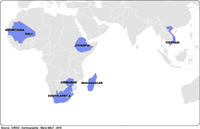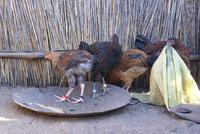Avian Influenza in developing countries - GRIPAVI
Last update: 19 January 2018
Dates: 2008-2012
Summary
Our limited knowledge of the epidemiology of AI viruses is hindering efforts to adapt control measures to developing country contexts. To do so, we need (1) to better understand the transmission of these viruses, distinguishing virus dispersion by wild birds and domestic poultry and specifying the viruses’ persistence mechanisms in infected countries, (2) to evaluate current and future control methods by modelling virus spread and (3) to develop surveillance methods that are adapted to the specific epidemiological features of these infections and to the control methods available.
To address these issues, the project is divided into four components:
- Deepen knowledge of the ecology (emergence, dissemination, endemism) of avian influenza and Newcastle disease in tropical regions (Component 1)
- Establish decision support tools for the surveillance and control of these two diseases (Component 2)
- Train and inform stakeholders and decision makers (Component 3: Information, Component 4: Training).
The project had 6 study sites: Mauritania, Mali, Ethiopia, Madagascar, Zimbabwe and Vietnam
In Zimbabwe, the project focused on component 1, the eco-epidemiology of AIV and NCD between wild and domestic birds.
The epidemiological cycle of avian influenza (AI) involves interactions between the viruses, hosts, susceptible species and reservoirs (wild and domestic birds, mammals), and their population dynamics at different scales: gatherings and migrations of wild birds, livestock systems, commercial networks. To date, few studies have been carried out to determine the environmental factors behind the endemism and spread of these viruses. The role of the environment (surface water, mud, etc.) in the persistence of the infection is poorly understood.
The complexity of the cycle is heightened by the genetic flexibility of influenza viruses, which enables them to adapt and evolve, and which leads to the emergence of new virus variants. Moreover, populations with varying virulence exist within the same viral sub-type. Lastly, despite a certain degree of host-virus specificity, jumping the species barrier is possible. This phenomena was illustrated by the case of H5N1, which is transmissible to people. Different questions arise regarding the interaction mechanisms between the viruses and their hosts which determine the evolution of viral populations and the emergence of epizootics.
To describe and analyze the cycles, this project component will conduct longitudinal studies in different ecosystems and regions in Africa. The characterization of viral strains present in Africa will create a reference data base that can be used to analyze links with strains identified in Europe and Asia.
Interaction between wild bird communities and virus populations
- Annual profiles of virus circulation in African wetlands
- Relationships between functional groups of wild birds and viral strains (co-evolution host-virus)
- Virus persistence modalities in African ecosystems
- Role of commensal bird species in virus transmission between domestic and wild birds
Virus – environment interaction
RIVERS project
Interaction between domestic animals and virus populations
- Comparison of strains circulating in domestic and wild bird populations
- Definition of contamination periods for domestic birds
- Circulation of viruses in domestic mammals and their role in maintaining viruses in the environment
Last update: 19 January 2018





